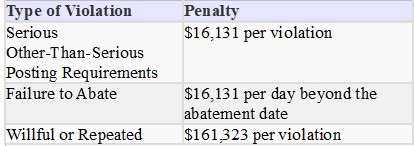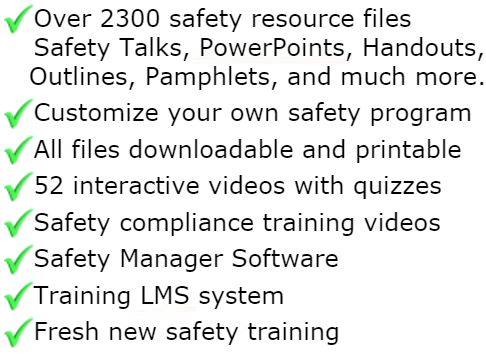
Workplace Safety Rules are Essential Elements in your Safety Program
These and other Task Specific Safety Rules can be used for developing posted safety rules, employee handbooks, job training or any of several other uses.
Safety Engineers have always relied upon three essentials, called the three E's.
Education, Engineering and Enforcement. Education means training, explaining the proper procedures of job responsibilities, safety rules and of course, constant awareness for working and acting safely.
Accident prevention through education and training. Engineering is finding safety hazards and correcting them before they contribute to an accident. Engineering also includes proper selection of equipment and facilities. Engineering focuses primarily on physical hazards in the workplace, but can also include job safety analysis, ergonomics and other safety engineering functions.
The third E is enforcement of safety rules. It doesn't do any good to have rules if they aren't enforced. This program addresses the enforcement of safety rules, so let's begin with some information relating to the causes of most injuries in the workplace.
Accident statistics from all industries have been compiled over the years by insurance companies and governmental agencies. The results of analyzing hundreds of thousands of accidents reveal 85 to 98 percent of all accident causes result from the unsafe acts of employees. There may be more than one cause of an accident, but most accidents are caused, in whole or in part, by the unsafe acts of employees.
BREAKING SAFETY RULES - WHAT IS AN UNSAFE ACT?
An unsafe act is any personal characteristic or condition that may cause or influence an employee to act unsafely. These conditions may be mental, emotional or physical. Some of the types of unsafe acts could be: unaware of the job hazard, inattention to job hazards, low level of job skill or inadequately trained for a specific job. It could be the employee tried to avoid extra effort or tried to gain or save time by taking a shortcut.
A slip and fall is an unsafe act because the employee could have prevented the slip and fall if he or she had been paying attention to the walking surface. Attention to the walking surface can prevent slips and falls even if the floor is uneven, slippery, wet or has a physical hazard, such as a hole or torn carpet.
Certainly the unsafe condition of the floor should be corrected, but that's not a reason to slip and fall. Inattention to the walking surface contributed to the accident.
That old safety slogan "Think Safety" means just that. Think about what you're doing, how you're going to do it and then use your judgment to perform the job without accident or injury. You're the only person who has control over unsafe acts.
One more example. Let's say you fall off a ladder. The unsafe act contributing to the fall was perhaps your inattention to the footing, or perhaps you exceeded the limitations of the ladder. You contributed to the accident.
Management is legally required to enforce safety rules. For a safety program to be judged effective, there are several elements or tests the program must pass.
1. Does the company have written safety rules and procedures?
2. Are employees advised of these rules through education and training?
3. Is the training documented? Documentation includes what information was taught, when it was taught and who provided the instruction.
4. Are safety hazards identified and corrected. This is why routine safety inspections are necessary and Action taken to correct identified deficiencies.
5. Are safety rules enforced? If yes, management must prove this with documentation.
If safety rules are not enforced then the company's safety program is not legally effective. Safety counseling serve several purposes, but the two most important purposes are:
The company is ensuring all safety rules are enforced, which is for the benefit of all employees in the workplace. Everyone benefits from a safe and healthful workplace.
AND, more importantly, the person experiencing the accident or injury is provided information and training to help prevent a similar incident in the future.
Safety is serious business and all employees must accept the responsibility for working and acting safely. There really aren't accident prone employees, there are, however, employees who have more injuries than others. This relates more to their attitude, experience, training, awareness and safety behavior. Perhaps they haven't been counseled so as to effect a change in their safety behavior. Don't blame accidents on accident proneness. Training, education, supervision and counseling is the most effective method of changing "accident proneness" to good safety behavior.
GENERAL SAFETY RULES AND WORK PRACTICES for employees
Regardless of your job, there are some basic safe work practices that should be observed by everyone working on the job site. The objective of the safety program is to prevent injuries and to allow you to do your job efficiently and safely. It takes an effort on your part to support the safety program but, after all, that's what it's all about.
Everyone must follow these safety rules and safe practices and provide every possible aid to safe operations and be a part of the program by reporting all unsafe conditions or practices to your supervisor or superintendent. The vast majority of work related injuries are the result of unsafe acts of workers. That means, when you take shortcuts, you violate safety regulations or simply don't take safety seriously, injuries are more likely to occur. Your company has a responsibility and obligation to make sure that all employees observe and obey all applicable company, state or Federal regulations and order as is necessary to the safe conduct of the work and must take such action as necessary to obtain compliance.
If you violate company safety rules, or you work in an unsafe manner, you will be provided a written safety counseling. This counseling will explain what the unsafe behavior was and how to correct it. If it's a minor violation, then the counseling will serve as a reminder for the proper procedure. If it's a serious violation, or you continue to exhibit unsafe behavior, disciplinary action may be warranted. The purpose of safety rule enforcement is the protection of all employees. One employee's unsafe behavior can affect the safety of other employees and safety is too important to allow unsafe behavior or unsafe conditions.t.
It is each employee's responsibility to work and act safely every day on every job. Training is simply making you more aware of safety and safety rules and it's your job to work safe and act safely every day.
Anyone known to be under the influence of drugs or intoxicating substances which impair the employee's ability to safely perform the assigned duties shall not be allowed on the job while in that condition. If you are taking medication prescribed by a physician or taking over-the-counter medication, be sure to tell your supervisor before you begin work. Some medications may impair your ability to work or operate equipment safely. We discussed unsafe behavior and how it leads to injuries on the job. Unsafe behavior includes horseplay. Scuffling, practical jokes and other acts which tend to have an adverse influence on the safety or well being of other employees. No one shall knowingly be permitted or required to work while the employee's ability or alertness is so impaired by fatigue, illness, or other causes that they might unnecessarily expose the employee or others to injury.
Work must be planned and supervised to prevent injuries in the handling of materials and in working together with equipment. Employees shall not enter manholes, underground vaults, chambers, tanks, silos, or other similar places that receive little ventilation unless it has been determined that it is safe to enter. Confined spaces can be quite hazardous from toxic fumes, gas, and other hazards can gather in the spaces creating a dangerous hazard.
Machine guards and other protective devices must be in their proper place before machinery and equipment is used and employees must report any deficiencies or hazards to the supervisor when they are detected. If the equipment is unsafe to operate, do not operate the equipment until it has been replaced or repaired.
Crowding or pushing when boarding or leaving any vehicle or other conveyance is prohibited.
Employees must not handle or tamper with any electrical equipment, machinery, or air or water lines in a manner not within the scope of their duties unless they have received instructions and authorization from their supervisor.
If you are injured on the job, report the injury immediately. Don't wait. Report the injury when it occurs, even if you believe that medical treatment is not necessary. If medical treatment is required, it will be provided.
When lifting any thing, use the power of your legs and not your back. If you keep your back in its natural curvature by bending your legs, it's difficult to suffer a back injury.
Inappropriate footwear or shoes with thin or badly worn soles must not be worn. Wear proper footwear and clothing on the job. Materials, tools, and other objects shall not be thrown from structures until proper precautions are taken to protect others from the falling objects.
Housekeeping is important to everyone's safety so take time to keep your work area clean. If you see a hazard, correct it. If you can't correct the hazard yourself, report it so it can be corrected.
When handling chemicals or hazardous substances be sure to use personal protective equipment as necessary and follow the instructions provided on the chemical label. Never use gasoline for any type of cleaning purposes. Wash your hands and skin after handling chemicals and hazardous materials.
When using ladders, inspect the ladder before using it to make sure it is in good condition and will carry the load. Using the proper ladder on the job is equally important. Never stand on the top two steps of a ladder, and when using straight ladders, make sure the ladder extends at least 3 feet above the landing, or where the ladder is positioned on the structure.
No source of ignition shall be applied to any enclosed tank or vessel, even if there are some openings, until it has been first determined that no possibility of explosion exists. An authority for the work is obtained from your supervisor. Persons using welding equipment must always be concerned in starting fires from the sparks or flash. Never weld around combustible or flammable material and, if necessary, have someone standing by with a fire extinguisher during welding operations.
When using tools and equipment, maintain these tools and equipment in good serviceable condition. Damaged tools or equipment must be removed from service and tagged "defective." Pipe or Stilson wrenches must not be used as substitute for other wrenches. Only appropriate tools shall be used for a specific job.
Vises must be equipped with handles and not used to punch or pry. A screwdriver should not be used as a chisel. Portable electric tools shall not be lifted or loaded by means of a power cord. Use ropes, not the power cord for lifting or lowering electrical tools. Before electrical tools are used, they must be inspected to make sure the power cord and plugs are in good condition. Cords with cuts or fray must be replaced. You cannot simply wrap electrical tape over a cut or frayed cord.
Only those persons who are trained and authorized may operate machinery or equipment. Loose or frayed clothing, long hair, dangling ties, finger rings, necklaces, and other potentially hazardous items may not be worn around moving machinery or other areas where they become entangled. Machinery shall not be serviced, repaired or adjusted while in operation, or shall oiling of moving parts be attempted, except when equipment that is designed or fitted with safeguards to protect the person performing the work. Where appropriate, lockout-tagout procedures must be used. If you see a piece of equipment or a machine that is locked out and tagged out, do not attempt to operate this equipment. A lock and tag means that someone is working on that machine and could possibly be injured if the equipment were to be inadvertently started.
Employees shall not work under vehicles or other equipment supported by jacks or chain hoists without protective blocking that will prevent injury if jacks or hoists should fail.
Air hoses shall not be disconnected at compressors until the hose line has been bled and is free of any air pressure.
Watch out for moving vehicles and equipment on the job site. Often this equipment is noisy and the operator may not be able to hear or see you. You have the responsibility for watch out for moving equipment.
There are many more safe practices and rules that could be listed, but it's impossible to list them all. Actually, safety is simply using common sense and good judgment. If something appears to have the potential for injury, then that's the time to take steps to make sure the injury doesn't occur.
Teamwork - everyone's cooperation and a special effort can result in a safe and helpful work environment. If you take safety seriously, you'll have a much better attitude about yourself and your job. Take time for safety, because safety really does make a difference.
All materials in the members area for this topic index

GET INSTANT ACCESS
to THE MEMBERS LIBRARY
Safety materials created by safety professionals.
Access to the Safety Manager software.
Wide variety of safety videos and courses.
**Brand New** Safety Training Management System
Pre-Made Safety Materials Ready For Use
Created by experienced safety professionals & risk consultants. Saving you time, money, and risk of injuries.
95% of the work already done.
Below are the maximum penalty amounts, with the annual adjustment for inflation, that may be assessed after Jan. 15, 2024. (See OSHA Memo, Jan. 8, 2024).

**New OSHA HEAT 90 DAY**
>>Download Free HERE<<
**New 2024 OSHA 300 Form**
>>Download Free HERE<<
**Brand New**
Free with full membership subscription
Training LMS System
Ask The Safety Consultant
Safety Equipment Deal Finder

“SafetyInfo.com is the first go-to website for safety professionals and companies to use in establishing a solid safety program"
-Mike McKenzie, Certified Safety & Health Manager (CSHM), McSafety Solutions™
Note: You must have a full subscription to the Safety Library in order to use this material. Any use outside of your organization, for resell, or without an active membership is strictly prohibited and may result in prosecution under copyright infringement laws. Please contact us first, if you would be interested in reselling or using our materials for reproduction.
Inside the Members Library
Topic Index
Accident Prevention
Air Quality
Asbestos
Bloodborne Pathogens
Boilers
Chemical Safety
Compressed Gas
Confined Space
Construction
Construction Worksite
Cranes & Slings
Driver / Fleet Safety
Drug Free Workplace
Electrical
Emergency Management
Engineering Safety
Environmental
Equipment
Ergonomics
Fall Protection
Fire Safety & Prevention
First Aid
Flammable Materials
Forklifts
Hazard Communication
Hazardous Materials
Hearing Protection
Heat Stress
Hot Work
Housekeeping
Job Safety Analysis
Laboratory
Ladders
Lead
Lockout-Tagout
Machinery & Equipment
Material Handling
MSDS (SDS)
Medical & First Aid
Occupational Health
Office Safety
Off the Job Safety
Personal Protection
Process Safety
Record Keeping
Respiratory Protection
Silica Safety
Rules & Policies
Signs & Labels
Slips, Trips & Fall
Training
Terrorism Programs
Tool Safety
Vehicle & Driver
Violence Programs
Welding & Hot Work
Training Videos
Library Index
Training Materials
Videos/Courses
Talks
Articles
PowerPoint
Handouts
Training Overheads
Quizzes
Supervisor Briefs
Management Briefs
Safety Sessions
2 Minute OSHA Safety Talks
Pamphlets
First Aid Training
Supervisor Training
Hazardous Materials
Bomb Threat
Crossword Puzzles
Biological Agents
Forms & Documents
Forms
Checklists
Audit Guides
Inspections Guides
Signs & Labels
Environmental Audit Guides
Recordkeeping - OSHA 300
Sign & Label Maker
Safety Management Resources
Safety Manuals/Written Programs
Ergonomic Programs
Emergency Plans
Process Safety Management
Construction Safety
Occupational Health
Environmental
Topic Sheets
DOT Fleet-Driver
Hazardous Materials
Chemical Safety
Drug Free Workplace
Terrorism Programs
Development Guides
Safety Manager Software
Safety References & Graphics
Technical Safety Information
Posters
Topic & Fact Sheets
Development Information
Job Specific Safety Rules
Terrorism
Calculators
Safety Comic Strips
New Safety Training System
Schedule and train your employees with our materials. Add unlimited amount of employees. Record all progress and issue certificates. For group and individual training sessions.

